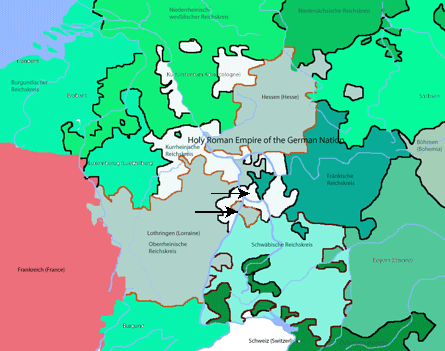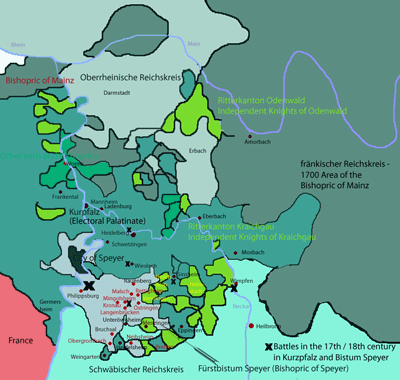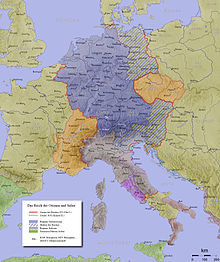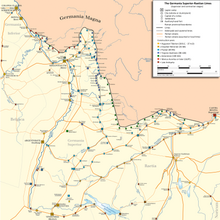A Short Glance to History of the region
Since 1738 almost every ancestor lived in a region of present-day Nordbaden. The region is called Kraichgau (open area near the creek Kraich) or very ancient Bruhrain (swampland between small hills). Very roughly it is a region between the cities of Heidelberg, Heilbronn, Karlsruhe and (behind the Hardtwald) Speyer. The swampland disappeared due to a correction of the Rhine-river in the 19th century. Today it's a region with small factories and offices and some agriculture (wine, sugar-beet, wheat, stock-farming). In the beginning of the 20th century the people worked in the agriculture (tabacco, sugar-beet, hops, stock-farming) and in small factories producing furniture, shoes or cigares. In the history the names and political parishes changed, especially in the end of the 20th century, in the beginning of the 19th century and in the end of the Middle Ages.
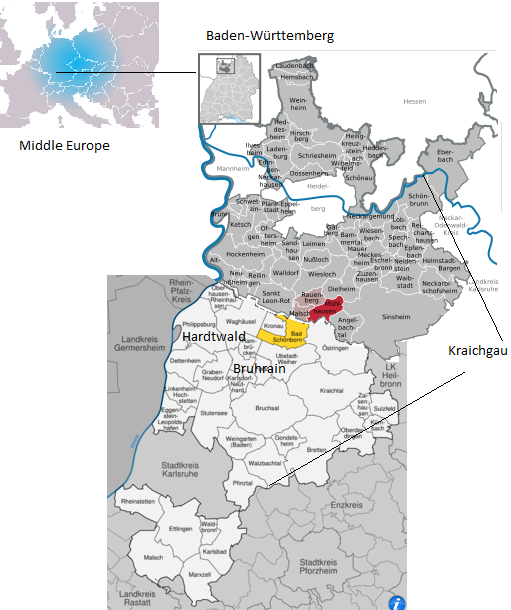 The Kraichgau in Baden-Württemberg in Middle Europe today.
The Kraichgau in Baden-Württemberg in Middle Europe today.
In the 1970th the names of many villages have changed to simplify the administration. Rettigheim is now part of Mühlhausen, Mingolsheim and Langenbrücken made up the new village Bad Schönborn. As result of the world war II refugees from German speaking parts of Eastern Europe did come to these villages in the 1950th and 1960th, later also foreign workers. The states Baden and Württemberg joined together to make up Baden-Württemberg.
During the world war I the most young men fought on the West Front in France and Belgium. At home some people died weakend by hunger and deseases. During the world war II the German soldiers fought nearly everywhere, but mostly on the Eastern Front in the Sovjet Union. After world war II first French troops occupied the surrounding of Langenbrücken and Rettigheim. Air bombing, destroying for example the nearby cities of Bruchsal, Mannheim and Karlsruhe, had brought the war to the guilty Germans, already. The first weeks of occupation were very hard, especially for the women. After the French troops American troops took the power. Life went on.
You may have recognized, that in the 19th and the first half of the 20th century the ancestors stayed in their villages for generation. Except of those who left Germany for ever to North- and South-America, to the French colonies or eastern Europe. In the Hungarian-Austrian Empire and the South of the Russian Empire the war against the Turks had left deserted areas attracting settler from Germany, especially when the outbreak of the Indonesian volcano Tambora led to a year without summer in 1817 and great hunger. Some left their home after the defeat of the democratic and liberal movement during the revolution of 1848-49 in Baden - especially such who fought in the Baden Army against Prussian troops.
In the beginning of the 19th century the frontier of the inner German states had changed by order of French conqueror Napoleon. But also serfdom had been abolished. But Military service in the Grand Duchy of Baden was introduced by the duke. The young men had been sent into the auxiliary troops of Napoleon's Grande Armee from which only a few of them returned home. Before Napoleon the prince-bishop of Speyer reigned over the villages and claimed serfdom. The villages belonged to the Bishopric of Speyer. Over the years 1763 to 1767 some left their homes, invited by Catharine the Great to settle at the banks of the Wolga river in the Russian Empire.
In the first half of the 18th century there were some wars against France (1701-1714 and 1733-1738) and against Prussia, Bavaria and France during the War of the Austrian Succession (1740-1748). The later one terminated already 1744 in the Bishoric of Speyer but troops (also Hungarian) were still occupying the region of the Bishopric of Speyer, whereas Bavarians stayed in the Electoral Palatinate because of the relationship between the Count of Palatinate and the Bavarian King. 1743 the Frenchmen had been driven back after the British, Hannoverian and Austrian troops triumphed over France and Bavaria in Dettingen in the North-West of Palatinate. The war were fought mainly in Canada, Italy, Bohemia and Silesia. During 1733-1738 ( The War of Polish Succession ) there were heavy fights between German and French forces round Philippsburg. In July 1734 the fort of Philippsburg fell after a siege of two months. 86,000 bullets and 25,000 bombs had been shot into the city of Philippsburg within 6 weeks. The French superiority was to great (see Wikipedia). But even German farmers had to built trenches. In Zeutern near Langenbrücken and Rettigheim a small battle took Place between French and German forces. 1735 German and Russian forces besieged the fort of Philippsburg. 1736 preliminary peace terms were reached and Philippsburg was given back to the Holy Roman Empire in 1737.
1701-1714 The War of Spanish Succession. Kehl, another fort at the Rhine River had been occupied by the Frenchmen. Defeated German troops pull back under the walls of Phillipsburg, which wasn't prepared. On 02/14/1704 there was a bombardment of Phillipsburg. In the battle of Hochstätt German, Dutch and British troops defeated the French army. 1713 Ludwig of Baden used his whole army to shelter Philippsburg. 100 French boats were prepared to bring troops to besiege the fort when the German army should have withdrawn to protect Freiburg. Because of their confession Waldenses from France migrated in large numbers in our area.
Despite the wars there was a little recovery after what had happened before. The region of Speyer and Heidelberg had been used only as a pledge by France government during the wars in the 18th century.
The slogan of the French army of the 17th century was "burn the Palatinate" to secure its vast territorial gains.
On the map you can see the Holy Roman Empire in the 16th century. The "Reichkreise" (different greens) were executive organisations of the Empire. They had to deliver soldiers (Reichsheer). Other parts of the troop were built by the forces of the Emporer - mostly Habsburgian (In this text both troops are called German troops). In the centre you can see the Electoral Palatinate and the Bishopric of Speyer. Click to enlarge.
The Electoral Palatinate (smaller arrow) belonged to the kurrheinische Reichskreis, The Bishopric of Speyer (larger arrow) to the Oberrheinische Reichskreis. We zoomed in into the next map and moved 100 year ahead. Here you can see the Bishopric of Speyer (arrow) in the year 1700. Click to enlarge.
French border had been widely moved to East. There were many battles in these centuries. The Holy Roman Empire was to weak to stop them, because of the attacks of the Turks, which were encouraged by French attacks. From 1688 to 1697 the Nine Years' War or Palatine Succession War was fought in Bishopric of Speyer. In South-West Germany and especially in Palatinate and the Bishopric of Speyer the people suffered enormly. 9/27/1688 the 32-day siege of Phillipsburg began, on October 5, they started the bombardment. On 29 October the Germans capitulated. The citys of Heidelberg, Mannheim, Bruchsal and Worms had been destroyed. They brought the loot to Philippsburg. 7/2/1689 they burned down Speyer and tried to burn down even the cathedral of Speyer and destroyed the tombs of the earlier German rulers. 5/22/1691 the French troops sieged Heidelberg again which capitulated. The Frenchmen blew up the castle and drove the population to Philippsburg, where many died. All the years til the end of the war the French army destroyed cities again, even in Württemberg. In Philippsburg the death rate was high because of the many people, prisoners of war, refugees and soldiers and there was a fire. On 14 July 1698 the Frenchmen left Phillipsburg after many demolitions and harassment. The city had to pay for the loot they left. During the occupation of the Electoral Palatinate in the neighbourhood the French troops forced many citizens back to Catholic confession. The Counts of Palatinate had meanwhile changed to the Wittelsbacher-Neuburger Line and were Catholic, too. The new one attempted to force the citizens of Heidelberg to Catholic confession, didn't work and the Count moved the Palatinate's capital from Heidelberg to the new city of Mannheim in 1720. Philippsburg and Kehl became strongholds of the empire. We don't know very much about what happened in the villages in this time, because also many archives had been destroyed by the war. Perhaps, the war before from 1672 to 1678 was even more brutal. The French army fought it with the slogan "Brulez Ie Palatinat!" - French policy of annihilation: "Burn the Palatinate". Almost all had been destroyed. Sometimes these wars are called robbery-wars of the French king. This wars were as destructive as the Thirty's Year War for our area. The French crown managed it to establish the Rhine river as border of South-Western Germany. In the middle of the campagne there was the stronghold Philippsburg nearby the villages of my ancestors and the city of Heidelberg. The stronghold Philippsburg had been occupied by French troops from 1645 until 1676. Often the Frenchmen made raids in the neighbourhood, destroying for example mills. 1672 France won the battle of Sinsheim. 40,000 Germans began the siege of the fort of Philippsbug 1676. On 31. July during an attack of the stronghold 800 German soldiers had been killed. New French troops arrived. They wanted to hold the fort by all means. In December the Germans get the fort again. (The Duke of Lorraine and later the Count of Baden took great effort to fight against the French army, whereas the Duke of Luxemburg was fighting for France.) After the Turks were defeated by an alliance led by the Polish-Lithuanian Commonwealth in 1699 the Empire grew slowly strong again.
Pestilence pandemics and Malaria were also a hazard to the humans in this time. Malaria was widespread because of the
swamplands near the Rhine. 1666 the pestilence came to Philippsburg. Not only the black death, the Thirty Years' War and
the Turks were a reason for weakness but also the deep mistrust between
catholics and protestants in the German states. The stronghold Philippsburg was built by prince-bishop von Sötern of Speyer
before the Thirty Years' War had started. He felt jeopardized by the protestant Electoral Palatinate and the
protestant Swabians. During construction citizens from the city of Speyer and forces from Palatinate destroyed the work. But
Thirty Years' War began and he was supported by the emporer of the Holy Roman Empire. Troops fighting for the Emporer (Habsburg)
were garrison under Bamberger. In 1622 in Mingolsheim and later in Wimpfen battles have been beaten. Langenbrücken
were completely destroyed by protestant troops in 1621.
Why did the Thirty years' war begin in Bohemia and the region
of Heidelberg and Speyer? Protestant Bohemia wanted to keep its old laws and a kind of independance of the emporer.
The protestant Count of Palatinate (son-in-law of the English King) had been elected to take crown of Bohemia.
This was a provocation to the
catholic Habsburgian Emporer but not against the law. General Tilly of the catholic Bavarian Duke and the Habsburgian emporer
defeated the Count near Prague. The Emporer got the crown. Like so many Habsburger before and after him he
broke the law. Tillys' forces followed the Count of Palatinate and his shady and criminal General Mansfeld to Heidelberg.
In Mingolsheim and Wimpfen they beat the battles. In Wimpfen Tilly defeated the protestants - mainly troops of
the Earl of Baden-Durlach, but wasn't strong enough to follow Mansfeld and stop the war in the whole Holy Roman Empire.
Later Swedish Troops came into Germany to fight for the protestants. Meanwhile, Prince-bishop Von Sötern had sold Philippsburg
to the catholic French crown, but the German commander Bamberger refused to give it over. Later he was defeated by
the protestant Swedish troops which then sold the stronghold to catholic French crown.
Bamberger occupied Philippsburg again, but at the end of the war he was defeated by the French army.
So the stronghold could be used to conquer the Palatinate and the Bishopric of Speyer by the French army until the Germans occupied
the stronghold again. This alternated two centuries, until Napoleon ordered to blew up the stronghold.
Not all the time before the quarrels and mistrust had been between the rulers of Palatinate and Bishopric of Speyer. In 1525 Malsch was destroyed and all males had been killed by the forces of the Count of Palatinate helping his "neighbour" the Prince-Bishop of Speyer defeating the peasants during the German Peasant's War.
In the Middle Ages the Bishopric of Speyer and the Palatinate were one of the cultural centres of Europe. The cathedral of Speyer is from this time (Salian Dynasty, Rhenish Franconia).
Speyer in the center of the Holy Roman Empire in the 11th century.
In the time of the Germanic tribes first the Allemani had moved into the region where Celts and Romans lived. Many Celtic tombs can be found here. They Germanizied them. The Allemani were defeated by the Franks in the early Middle Ages. The region is a kind of border between the Allemanic (Swabian) speaking South and East and the Franconian speaking North-West, even today. Although the culture and language changed, this must not mean, that all the Celts or Allemani and other peoples living here before were killed. The border of dialects is surprising, because the Thirty's Year War killed estimated one third of the population of Southern Germany (in towns estimated 25 %, rural regions 40 % - most of them didn't died by weapons, the bishop of Speyer wrote 1623 to the pope, that 75% of the bishopric's population were fled or dead), but dialect border didn't change enormously.
Ladenburg near Heidelberg and Wimpfen were important towns and castles of Germania Superior during the Roman empire.
Here some links about history:
http://www.club-rheingrafvonsalm.de/html/geschichte.html is an excellent site
about the history of Philipsburg. Only in German but it is worth to be translated.
http://en.wikipedia.org/wiki/Bishopric_of_Speyer
